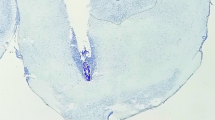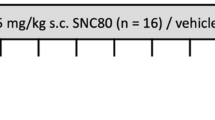Abstract
We have previously (Daugé et al. 1988) demonstrated that injection of the μ agonist [d-Ala2, MePhe4, Gly-ol5]-enkephalin (DAGO) or the δ agonist [d-Thr2, Leu5]-enkephalyl-Thr6 (DTLET) into the rat Nucleus accumbens (N.Acc.), or Nuceeus caudatus (N.Caud.) induced a hypoactivity followed by hyperactivity 150 min later in the case of the μ agonist and a hyperactivity in the case of the δ agonist. Moreover, naloxone reversible delta-type responses were obtained by local infusion of kelatorphan, ([(R)-3(N-hydroxylcarboxamido-2-benzylpropanoyl)-l-alanine]), a complete inhibitor of enkephalin catabolism, suggesting a tonic control of the behavioral activity of rat by the endogenous opioid peptides. In this work, the putative involvement of the dopaminergic system in these behavioral responses was investigated by using the DA antagonist thioproperazine. In the N.Acc., the behavioral effects of kelatorphan, or of μ or δ agonists were not altered by thioproperazine-induced blockade of dopamine receptors. In contrast, the hyperactivity produced by DTLET or by kelatorphan in the N.Caud. was reversed by thioproperazine while the time-dependent biphasic effect resulting from DAGO injection remained unaffected by the DA antagonist. This blocking effect of thioproperazine is in agreement with the previously described δ-selective enhancement of the release of newly synthesized DA in the striatum but not in the N.Acc.
Similar content being viewed by others
References
Algeri S, Brunello N, Calderini G, Consolazione A (1978) Effect of enkephalins on catecholamine metabolism in rat CNS. Adv Biochem Psychopharmacol 18:199–209
Atweh SF, Kuhar MJ (1977) Autoradiographic localization of opiate receptors in rat brain, II. The brainstem. Brain Res 129:1–12
Biggio GH, Carn M, Corda G, Dibello C, Gessa GL (1978) Stimulation of dopamine synthesis in caudate nucleus by intrastriatal enkephalins and antagonism by naloxone. Science 200:552–554
Bourgoin S, Le Bars D, Artaud F, Clot AM, Bouboutou R, Fournié-Zaluski MC, Roques BP, Hamon M, Cesselin F (1986) Effects of kelatorphan and other peptidase inhibitors on the in vitro and in vivo release of Met-enkephalin-like material from the rat spinal cord. J Pharmacol Exp Ther 238:360–366
Bozarth MA, Wise RA (1981) Intracranial self-administration of morphine into the ventral tegmental area in rats. Life Sci 28:551–555
Britt MD, Wise RA (1983) Ventral tegmental site of opiate reward: antagonism by a hydrophilic opiate receptor blocker. Brain Res 258:105–108
Chesselet MF, Cheramy A, Reisine TD, Lubetzki C, Glowinski J, Fournié-Zaluski MC, Roques BP (1982) Effects of various opiates including specific delta and mu agonist dopamine release from nigrostriatal dopaminergic neurons in vitro in the cat. Life Sci 31:2291–2294
Costa E, Cheney DL, Racagni G, Zsilla G (1975) An analysis at synaptic level of the morphine action in striatum and N. accumbens: dopamine and acetylcholine interactions. Life Sci 17:1–8
Cotton R, Giles MG, Miller L, Show JS, Timms D (1984) ICI 174,864: a highly selective antagonist for the opioid δ receptor. Eur J Pharmacol 97:331–332
Cowan A, Zhu XZ, Mosberg HI, Omnas JR, Porreca F (1988) Direct dependence studies in rats with agents selective for different types of opioid receptors. J Pharmacol Exp Ther 246:950–955
Daugé V, Rossignol P, Roques BP (1988) Comparison of the behavioral effects induced by administration in rat nucleus accumbens or nucleus caudatus of selective μ and δ opioid peptides or kelatorphan, an inhibitor of enkephalin-degrading-enzymes. Psychopharmacology 96:343–352
Delay-Goyet P, Zajac JM, Rigaudy P, Foucaud F, Roques BP (1985) Comparative binding properties of linear and cyclic δ-selective enkephalin analogues: [3H]-[d-Thr2, Leu5]enkephalyl-Thr6 and [3H]-[d-Pen2, d-Pen5]enkephalin. FEBS Lett 183:439–443
Dickenson AH, Sullivan A, Fournié-Zaluski MC, Roques BP (1987) Prevention of degradation of endogenous enkephalins produces inhibition of nociceptive neurons in rat spinal cord. Brain Res 408:185–191
Eghbali M, Santoro C, Paredes W, Gardner EL, Zukin RZ (1987) Visualization of multiple opioid-receptor types in rat striatum after specific mesencephalic lesions. Proc Natl Acad Sci USA 84:6582–6586
Fournié-Zaluski MC, Chaillet P, Bouboutou R, Coulaud A, Cherot P, Waksman G, Costentin J, Roques BP (1984) Analagsic effects of kelatorphan, a new highly potent inhibitir of multiple enkephalin degrading enzymes. Eur J Pharmacol 102:525–528
Goeders NE, Lane LD, Smith JW (1984) Self-administration of methionine enkephalin into the nucleus accumbens. Pharmacol Biochem Behav 20:451–455
Hand TM, Franklin KB (1985) 6 OH-DA lesions of the ventral tegmental area block morphine-induced but not amphetamine-induced facilitation of self-administration. Brain Res 328:233–241
Handa BK, Lane AC, Lord JAH, Morgan BA, Rance MJ, Smith CFC (1981) Analogues of beta-LPH 61-64 possessing selective agonists of mu-opiate receptors. Eur J Pharmacol 70:531–540
Iwamota ET, Way LE (1977) Circling behavior and stereotypy induced by intranigral opiate microinjections. J Pharmacol Exp Ther 203:347–359
Johnson RP, Sar M, Stumpf WE (1980) A topographic localization of enkephalin on the dopamine cyclase activity in rat striatum. Abstract Society of Neuroscience 14th Annual Meeting Anaheim CA: 10-15
Johnson RP, Sar M, Stumpf WE (1981) A topographic localization of enkephalin on the dopamine neurons of the rat substantia nigra and ventral tegmental area demonstrated by combined histofluorescence-immuno-histochemistry. Brain Res 194:566–571
Joyce EM, Koob GF, Strecker R, Iversen SD, Bloom FE (1981) The behavioural effects of enkephalin analogues injected into the ventral tegmental area and globus pallidus. Brain Res 221:359–370
Kalivas PW (1985) Interactions between neuropeptides and dopamine neurons in the ventromedial mesencephalon. Neurosci Biobehav Res 9:573–587
Kalivas PW, Bronson M (1985) Mesolimbic dopamine lesions produce an augmented behavioral response to enkephalin. Neuropharmacology 24:931–936
Kalivas PW, Richardson-Carlson R (1986) Endogenous enkephalin modulation of dopamine neurons in the ventral tegmental area. Am J Physiol 251:R243-R249
Kalivas PW, Widerlöv E, Stanley D, Breese G, Prange AJ Jr (1983) Enkephalin action on the mesolimbic system. A dopamine-dependent and a dopamine-independent increase in locomotor activity. J Pharmacol Exp Ther 227:229–237
Kalivas PW, Richardson-Carlson R, Van Orden G (1986) Cross-sensitization between footshock stress and enkephalin-induced motor activity. Biol Psychiatry 21:939–950
Kelley AE, Stinus L, Iversen SD (1980) Interactions between D.Ala-Met-enkephalin, A10 dopaminergic neurons and spontaneous behavior in the rat. Behav Brain Res 1:3–24
Lubetki C, Chesselet MF, Glowinski J (1982) Modulation of dopamine release in rat striatal slices by delta opiate agonists. J Pharmacol Exp Ther 222:435–440
MacLennon AJ, Maier SF (1983) Coping and the stress-induced potentiation of stimulant stereotypy in the rat. Science 219:1091–1093
Matsumoto RR, Brinsfield KH, Patrick RL, Walker JM (1988) Rotational behavior mediated by dopaminergic and non-dopaminergic mechanisms after intranigral microinjection of specific mu, delta and kappa opioid agonists. J Pharmacol Exp Ther 246:196–203
Mauborgne A, Lutz O, Legrand J-C, Hamon M, Cesselin F (1987) Opposite effects of δ and μ opioid receptor agonists on the in vitro release of substance P-like material from the rat spinal cord. J Neurochem 48:529–537
Moskowitz AS, Goodman R (1984) Light microscopic autoradiographic localization of μ and δ opioid binding sites in the mouse central nervous system. J Neurosci 4:1331–1342
Mulder AH, Wardeh G, Hogenboom F, Frankhuyzen AL (1984) κ and δ opioid receptor agonists differentially inhibit striatal dopamine and acetylcholine release. Nature 308:278–280
Nabeshima T, Katoh A, Hiramatsu M, Kameyama T (1986) A role played by dopamine and opioid neuronal systems in stress-induced motor suppression (conditioned suppression of motility) in mice. Brain Res 398:354–360
Paxinos G, Watson C (1982) The rat brain. Academic Press, NY
Pert A, Sivit C (1977) Neuroanatomical focus for morphine and enkephalin-induced hypermotility. Nature 265:645–647
Petit F, Hamon M, Fournié-Zaluski MC, Roques BP, Glowinski J (1986) Further evidence for a role of delta opiate receptors in the presynaptic regulation of newly synthesized dopamine release. Eur J Pharmacol 126:1–9
Phillips AG, Le Piane FG (1980) Reinforcing effects of morphine microinjection into the ventral tegmental area. Pharmacol Biochem Behav 12:965–968
Phillips AG, Le Piane FG (1982) Reward produced by microinjection of (d-Ala)-Met-enkephalinamide into the ventral tegmental area. Behav Brain Res 5:225–229
Phillips AG, Le Piane FG, Fibiger HC (1983) Dopaminergic mediation of reward produced by direct injection of enkephalin into the ventral tegmental area. Life Sci 33:2505–2511
Pijnenburg AJJ, Honig WMM, Vanderheyden JAM, Van Rossum JM (1976) Effects of chemical stimulation of the mesolimbic dopamine system upon locomotor activity. Eur J Pharmacol 35:45–58
Pollard H, Llorens-Cortes C, Bennett JJ, Costentin J, Schwartz JC (1977) Opiate receptors on mesolimbic dopaminergic neurons. Neurosci Lett 7:295–299
Roques BP, Fournié-Zaluski MC, Soroca E, Lecomte JM, Malfroy B, Llorens C, Schwartz JC (1980) The enkephalinase inhibitor thiorphan shows antinociceptive activity in mice. Nature 288:286–288
Roques BP, Daugé V, Gacel G, Fournié-Zaluski MC (1985) Selective agonists and antagonists of delta opioid receptors and inhibitors of enkephalins metabolism. Potential use in treatment of mental illness. Biol Psychiatry 7:287–289
Scott Young III W, Bonner TI, Brann MR (1986) Mesencephalic dopamine neurons regulate the expression of neuropeptide mRNAs in the rat forebrain. Proc Natl Acad Sci USA 83:9827–9831
Shippenberg TS, Bals-Kubrik R, Herz A (1987) Motivational properties of opioids: evidence that an activation of δ-receptors mediates reinforcement processes. Brain Res 436:234–239
Stachura ME (1976) Basal and dibutyryl cyclic AMP-stimulated release of newly synthesized and stored growth hormone from perfused rat pituitaries. Endocrinology 98:580
Stinus L, Koob GF, Ling N, Bloom FE, Le Moal M (1980) Locomotor activation induced by infusion of endorphins into the ventral tegmental area: evidence for opiate-dopamine interactions. Proc Natl Acad Sci USA 77:2323–2327
Stinus L, Winnock MR, Kelley AE (1985) Chronic neuroleptic treatment and mesolimbic dopamine denervation induce behavioral supersensitivity to opiates. Psychopharmacology 85:323–328
Stinus L, Nadaud D, Jauregui J, Kelly AE (1986) Chronic treatment with five different neuroleptics elicits behavioral hypersensitivity to opiate infusion into the nucleus accumbens. Biol Psychiatry 21:34–48
Waksman G, Bouboutou R, Devin J, Bourgoin S, Cesselin F, Hamon M, Fournié-Zaluski MC, Roques BP (1985) In vitro and in vivo effects of kelatorphan on enkephalin metabolism in rodent brain. Eur J Pharmacol 117:233–243
Waksman G, Hamel E, Delay-Goyet P, Roques BP (1987) Neutral endopeptidase-24.11, mu and delta opioid receptors after selective brain lesions: an autoradiographic study. Brain Res 436:205–216
White JD, Stewart KD, Krause JE, Mekevy JF (1985) Biochemistry of peptide-secreting neurons. Physiol Rev 65:553–606
Wilcox RE, Bozarth M, Levitt RA (1983) Reversal of morphine-induced catalepsy by naloxone microinjections into brain regions with high opiate receptor binding: a preliminary report. Pharmacol Biochem Behav 18:51–54
Wood PL, Stotland M, Richard JW, Rackham A (1980) Action of mu, kappa, sigma, delta and agonist/antagonist opiates on striatal dopaminergic function. J Pharmacol Exp Ther 215:697–703
Zajac JM, Gacel G, Petit F, Dodey P, Rossignol P, Roques BP (1983) Deltakephalin, Tyr-d-Thr-Gly-Phe-Leu-Thr: a new highly potent and fully specific agonist for opiate delta receptors. Biochem Biophys Res Commun 111:390–397
Author information
Authors and Affiliations
Rights and permissions
About this article
Cite this article
Daugé, V., Rossignol, P. & Roques, B.P. Blockade of dopamine receptors reverses the behavioral effects of endogenous enkephalins in the Nucleus caudatus but not in the Nucleus accumbens: differential involvement of δ and μ opioid receptors. Psychopharmacology 99, 168–175 (1989). https://doi.org/10.1007/BF00442803
Received:
Accepted:
Issue Date:
DOI: https://doi.org/10.1007/BF00442803




